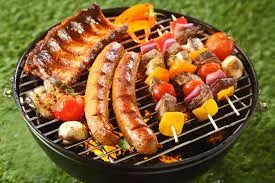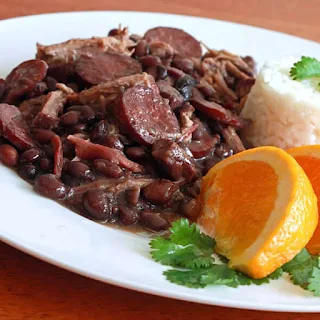Through my Foodie's journey around the world, including Asia, Africa, Europe, and North America, I am excited to share The Best South American culinary adventure, filled with fresh flavors, culture, and experiences.A
South American cuisine is incredibly diverse, reflecting the continent's varied geography and cultural influences. These are some of the best and most popular dishes from South America that people love to enjoy on all occasions.
1. Asado (Argentina):
Asado is the quintessential Argentine barbecue, known for its social and cultural significance. It typically involves grilling a variety of meats, such as beef, pork, chicken, and sausages (like chorizo), over an open flame or hot coals. The meat is often seasoned simply with salt, allowing the quality and flavor of the meat to shine, the cooking process could take hours depending of the quantity of the meat, the pieces vary from 600 g minimum to hole piece of the animal, and this the deference between Asado and other barbecue. The potatoes, vegetables, and salads are served with the meat.
Asado is more than just a meal; it's a social event where friends and family gather, often for hours, enjoying food, conversation, and wine.
2. Feijoada (Brazil):
Feijoada is a hearty black bean stew with a rich, smoky flavor, traditionally made with various cuts of pork, including sausages, pork belly, and ribs. Originating from Portugal but adapted in Brazil, it also includes ingredients like beef, bacon, and spices. It is usually served with rice, collard greens, orange slices, and farofa (toasted cassava flour). Feijoada is often enjoyed as a communal meal, typically on Wednesdays and Saturdays.
3. Ceviche (Peru):
Ceviche or cebiche, sebiche, or seviche is a refreshing and tangy dish made with raw fish or seafood, marinated in freshly squeezed lime or lemon juice, and mixed with onions, cilantro, and chili peppers. The acidity of the citrus juice "cooks" the fish. It is commonly served with sides like sweet potato, corn, and lettuce. Peru is particularly famous for its ceviche, with variations that might include additional ingredients like rocoto peppers and cancha (toasted corn).In Peru especially for summer and celebrations such as Fiestas Patrias.
4. Arepas (Venezuela and Colombia):
Arepas are round, flat cornmeal cakes that are a staple in both Venezuela and Colombia. They can be grilled, baked, fried, or steamed and are often split open and filled with a variety of ingredients, such as cheese, meats, avocado, and beans. The texture can range from crispy to soft, depending on the preparation method and each country has its own variations, such as the Venezuelan "arepa reina pepiada" (stuffed with avocado and chicken) and the Colombian "arepa de huevo" (filled with egg).
The history of corn cakes as it is known, dates back to the Spanish conquest in the pre-Colombian era when the different Indigenous groups harvested ornand made several preparations out of it as they considered as a gift from the gods.
5. Empanadas (Argentina and Chile):
Empanadas are savory pastries filled with a variety of ingredients. In Argentina, empanadas often contain a mixture of ground beef, onions, hard-boiled eggs, olives, and spices, all encased in a flaky dough and baked or fried. In Chile, they are called "empanadas de pino," with similar fillings but often larger and typically baked. They can also come with other fillings like cheese, chicken, or seafood.
The name Empanadas is a Spanish name that means: Empanar is to bread or to coat with bread, and most of south American country are very familiar with this dish: Peru, Argentina, Ecuador, ColombiaChile, Mexico, Uruguay, and Venezuela.
6. Pabellón Criollo (Venezuela):
Pabellón Criollo is Venezuela's national dish, consisting of shredded beef (carne mechada), black beans (caraotas negras), rice, and fried plantains (tajadas). The combination of savory beef, earthy beans, fluffy rice, and sweet plantains creates a balanced and flavorful meal. plus The juicy meat is first slow-cooked, shredded, and then added to fried onions, garlic, and bell pepper.
It's a reflection of the country's a diverse cultural heritage, combining Indigenous, African, and European culinary influences. It's indispensable at family and community festivities.
7. Ajiaco (Colombia):
Ajiaco is a traditional Colombian soup made with chicken, three types of potatoes (each adding a different texture), and a local herb called guasca, which gives the dish its distinctive flavor. It is typically served with corn on the cob, capers, cream, and avocado on the side. Ajiaco is especially popular in Bogotá and is often enjoyed as a comforting, hearty meal. It is estimated that the food dish originated with the Indigenous tribe of Taino who inhabited parts of the Caribbean including modern-day Cuba.
8. Churrasco (Brazil):
Churrasco is a Brazilian style of barbecue, similar to the Argentine asado but with its own unique elements. It features various cuts of beef, pork, lamb, and chicken, skewered and cooked over an open flame. The meat is was seasoned simply, often with just salt, and cooked to perfection by churrasqueiros (grill masters). It is commonly served in churrascarias (barbecue restcurrents) where waiters bring skewers of meat to the table and carve it directly onto diners' plates in front of the dinner.
Churrasco means barbecue in Portuguese, has its roots from the early 1800's when cattle-herding cowboys, or “gauchos” in the Pampas of southern Brazil would gather after butchering a cow to cook amazing large portions of meat over a wood-burning fire in the open field.
9. Choripán (Argentina):
Choripán is a popular Argentine street food made with chorizo sausage, grilled and served in a crusty baguette-like bread. It's often topped with chimichurri sauce, a vibrant and tangy blend of parsley, garlic, vinegar, olive oil, and red pepper flakes. Choripán is simple but packed with flavor, making it a favorite at soccer matches, street fairs, and casual gatherings.
The origins of this street food date back to the middle of the 19th century, during the period when South American Cowboys made Asados inside the bread.
10. Bandeja (Colombia):
The origin of the bandeja
Bandeja paisa is a traditional Colombian meal featuring rice, beans, plantains, avocado, arepa (a corn cake), and various kinds of grilled meats.
These 10 dishes are just a few examples of the amazing foods you can find in South America. Each country in the region has its own unique culinary traditions and flavors that make it a paradise for food lovers.



























0 Comments